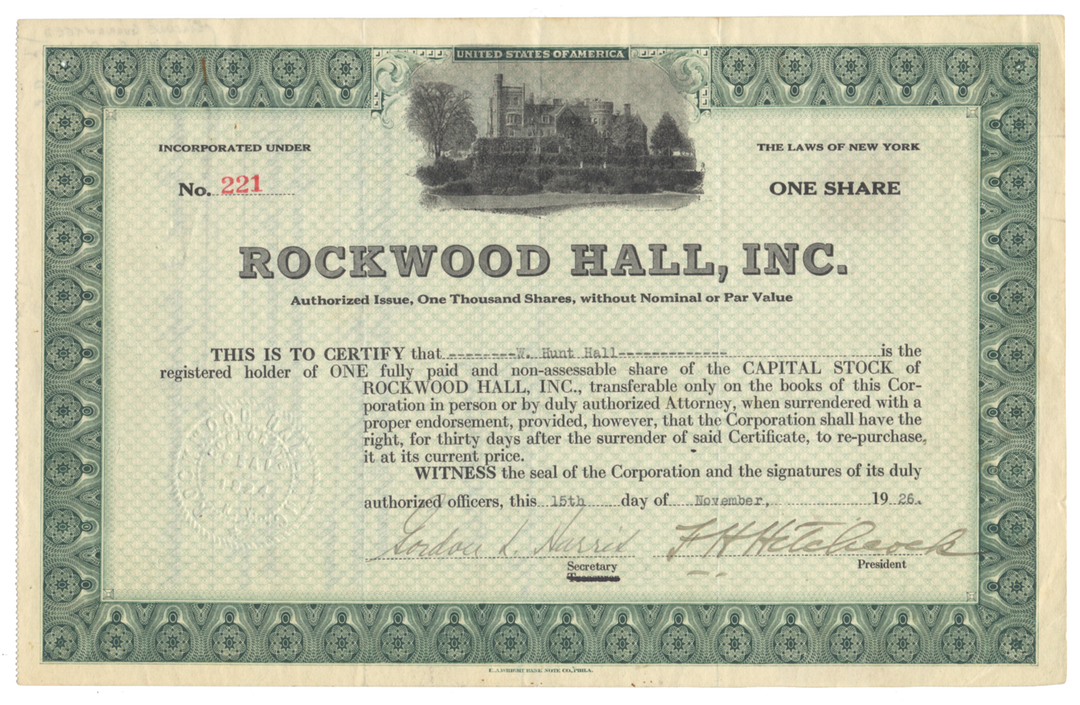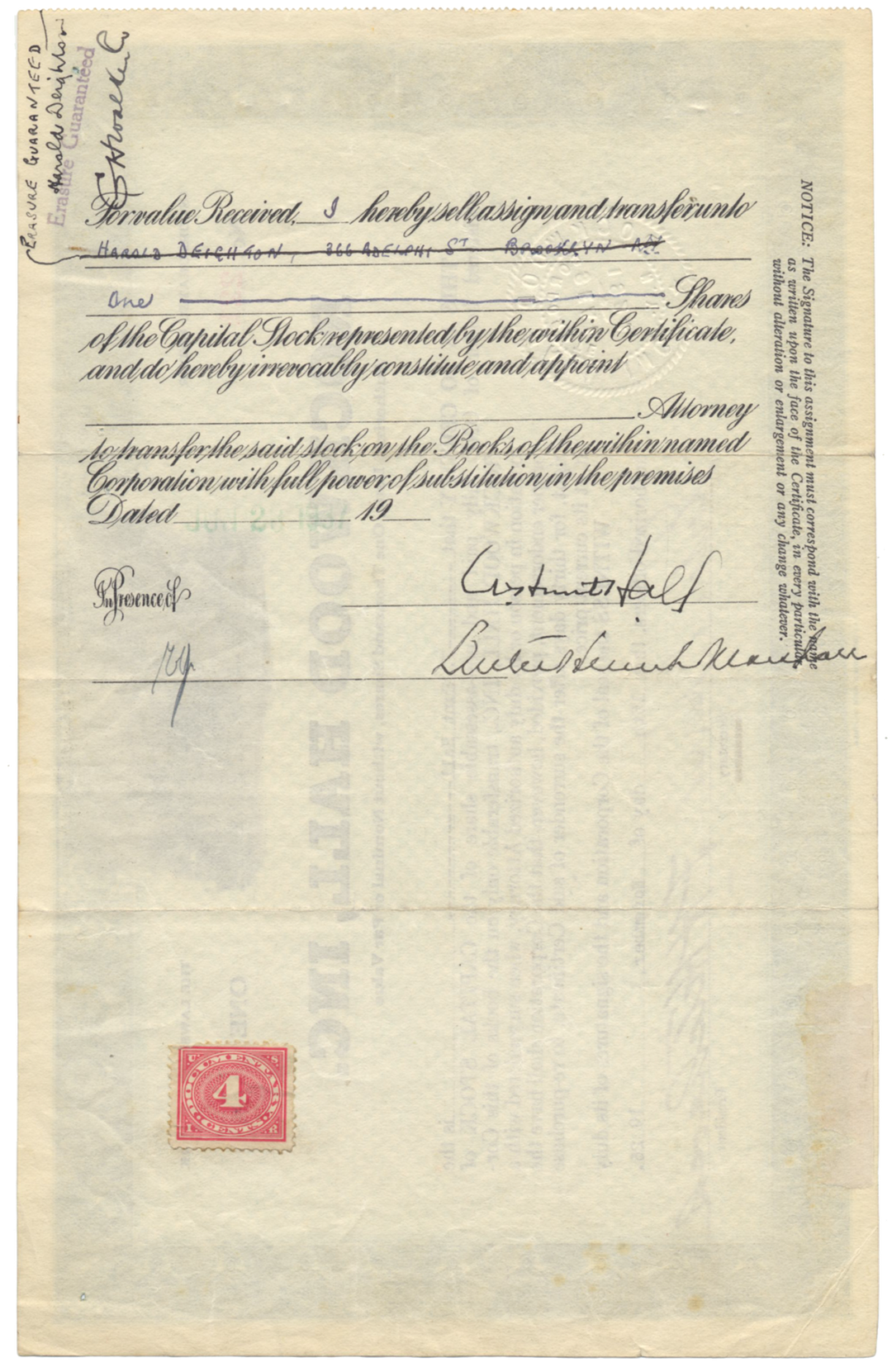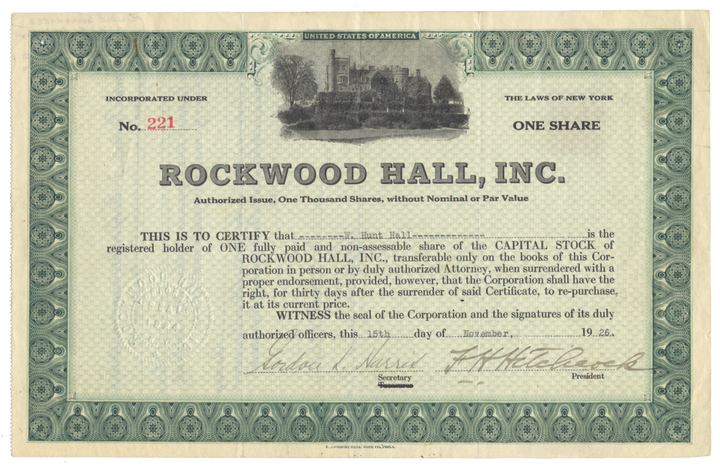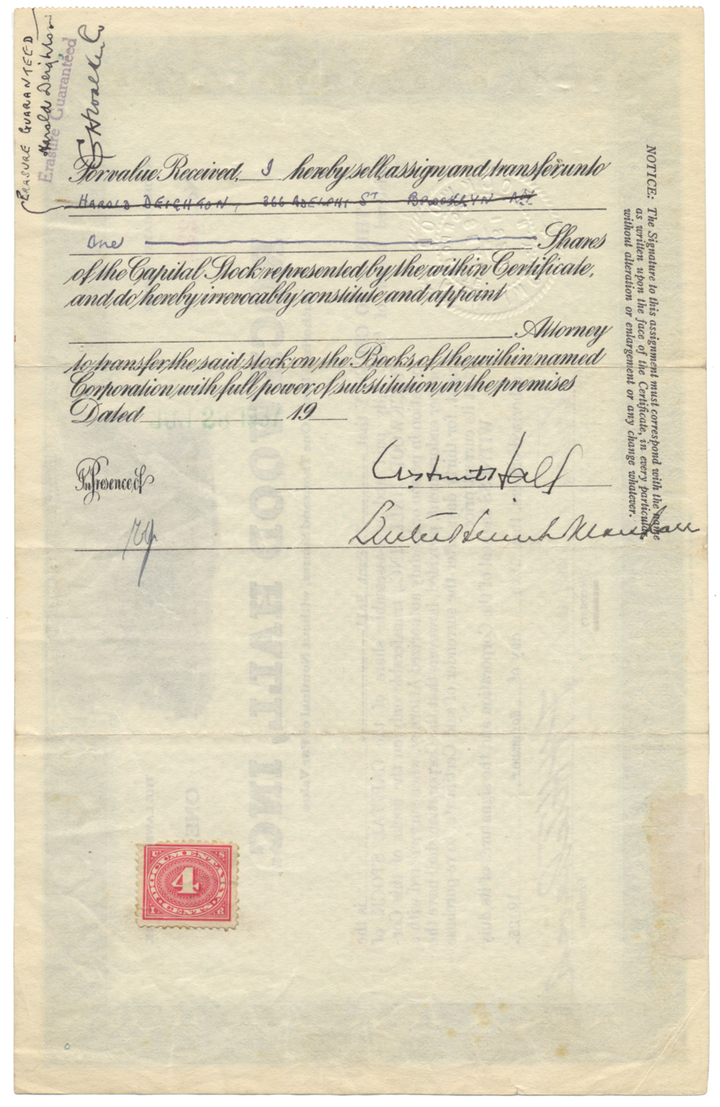Rockwood Hall, Inc. (Rockefeller Estate Development)
- Guaranteed authentic document
- Orders over $75 ship FREE to U. S. addresses
Product Details
CompanyRockwood Hall, Inc.
Certificate Type
Capital Stock
Date Issued
November 15, 1926
Canceled
No
Printer
E. A. Wright Bank Note Company
Signatures
Hand signed
Approximate Size
10 1/4" (w) by 6 1/2" (h)
Images
Show the exact certificate you will receive
Guaranteed Authentic
Yes
Additional Details
NA
Historical Context
One of the early owners of the property which eventually house Rockwood Hall was Alexander Slidell Mackenzie, who lived in a farmhouse there from 1840 until his death in 1848. Commodore Matthew C. Perry was accustomed to spending part of the summer with his wife in cottages near Mackenzie's farm. In 1839, Perry purchased a neighboring parcel and built a stone house, named The Moorings. They settled into this home as a year-round residence with their children. Around 1853 or 1854, Perry sold the country estate and moved back to New York City.
Importer and merchant Edwin Bartlett obtained the property around 1848, demolished the farmhouse, and built Rockwood, an English Gothic castle of locally-quarried stone. Bartlett hired Gervase Wheeler to design the house, which was built in 1849.
Bartlett sold the house to his business partner William Henry Aspinwall in 1860; Aspinwall made it his summer home and improved the property and house, and purchased enough land to make his estate 200 acres. Aspinwall would often travel from New York City to the property via his yacht Firefly, which he could moor to his dock at Rockwood Hall until his own death, in 1886. William Avery Rockefeller, Jr. then purchased it for $150,000. His residence in Mount Pleasant persuaded his brother, John D. Rockefeller, to build his estate Kykuit in nearby Pocantico Hills.
Rockefeller expanded his property to about 1,000 acres and either renovated or rebuilt the castle, nearly doubling its size. Some sources, including Rockefeller himself, claim he entirely rebuilt the house, and used the old stone to construct a new barn or stables.
Including Rockefeller's purchase of the property, he spent about $3 million ($90.5 million in 2021) on the house. He spared no expense in making it fit his characteristics and lifestyle, and even had little idea how much he would spend on it during its construction. Rockefeller hired Ebenezer L. Roberts to oversee the construction, though Roberts died in 1890, during the house's renovation. He also hired noted architectural firm Carrère and Hastings to create plans for interior renovation of the house. Rockefeller also spent $6,000 to repave a two-mile stretch of road with macadam from the Vanderbilt Shepard home Woodlea to Sleepy Hollow Cemetery. Rockefeller paid for the paving in order to travel easily from Rockwood Hall to the Tarrytown railroad station.
The resulting 204-room house was 174 x 104 feet and was the second-largest private house in the U.S. at the time, only behind the Biltmore mansion in Asheville, North Carolina. It was estimated at the time as second only to the Biltmore in cost as well, and as second to Kykuit in its extent of land and value, within Westchester County.
Rockefeller moved into the newly-renovated house around May 1890. In 1895, Rockefeller's daughter Emma married David Hunter McAlpin, Jr., son of David Hunter McAlpin in a ceremony at the house. Much of the house was decorated for the event. In 1914, during the Colorado Coalfield War, the Rockefeller brothers' properties of Rockwood Hall and Kykuit were the site of rioting and potential home invasion. Tarrytown village president Frank Pierson protected the homes, gathering more police and leading the effort to suppress the rioters and drive them away from the homes.
Rockefeller intended the house to be his summer retreat, yet in his later years it became his year-round home. In 1922, Rockefeller died within Rockwood Hall, leaving the property empty. His funeral took place in Rockwood Hall, with a service by the rector of Saint Mary's Episcopal Church, which Rockefeller regularly attended. The gates of the estate were closed and guarded by policemen during the affair.
Rockefeller's heirs put the property up for sale, however no individual buyer could be found. At this point, the mansion was closed, its furnishings were removed, and about 20 caretakers were tending to the property. The first breakup of his property was a sale to Frank Vanderlip. In 1924, Vanderlip purchased 57 acres of Rockwood Hall's riverfront property to add to his estate, Beechwood. The bulk of the estate was purchased that same year by a group of investors, who formed Rockwood Hall, Inc. Their company purchased the property (with 210 acres west of Route 9 and 600 acres east) for around $1 million. The group converted the estate into a country club with a golf course, a swimming pool, and other facilities. The company formed Rockwood Hall Country Club and took out a mortgage with the Equitable Trust Company of New York, which was acquired by Chase Bank in 1930. Its 18-hole golf course was designed by Emmet & Tull in 1929. Rockwood Hall Country Club hired noted Australian golfer Joe Kirkwood Sr. to be the club's first golf professional.
In 1927, Rockefeller's nephew John D. Rockefeller Jr. purchased 450 acres across Route 9 from Rockwood. In the following year, the Rockwood Hall club sold 166.5 acres of its own land east of Route 9 to John Jr., in order to settle or reduce two of its mortgages. By 1928, the club was profitable enough to plan to expand its property; the club planned for a second golf course on an adjacent property, as well as adjustments to most of its existing course and construction of four tennis courts and an outdoor pool. In the same year, Frederic N. Gilbert was removed as a member of the country club for allegedly trying to obtain control of it. Frank Harris Hitchcock was President of the club at the time, and had been the club's first president. Gilbert took legal action against the club.
The Rockwood Hall club was building up debts, especially during the Great Depression, which began in 1929. The club was ultimately not financially successful, and declared bankruptcy in 1936. During the summer of 1937, Rockwood Hall Country Club leased the house and grounds to the Washington Irving Country Club and the coachhouse and stable to the Washington Irving Theater during Rockwood's foreclosure suit. The coachhouse and stable were remodeled and began showing summer productions beginning in 1938 and ending by 1940.
Chase National Bank had acquired Rockwood's mortgage and began foreclosing on the property. In 1938, John Jr. purchased Rockwood Hall Country Club and its 220 acres from Chase Bank for $244,374 in bankruptcy court. By 1941, John Jr. found no use for the site and its buildings were deteriorating severely, so he prepared to demolish the buildings. In late 1941 and early 1942, John Jr. ordered the demolition of the mansion, coachhouse, greenhouses, powerhouse, barn, chicken house, pigeonhouse, sheds, and boathouse; only excluding the two gatehouses. Debris was to be dumped into the Hudson River, and care was taken to not damage the property's retaining walls, trees, shrubs, roads, and terraces. The last remaining structures are the gatehouse on U.S. Route 9 and the terraced foundation of the mansion.
Related Collections
Additional Information
Certificates carry no value on any of today's financial indexes and no transfer of ownership is implied. All items offered are collectible in nature only. So, you can frame them, but you can't cash them in!
All of our pieces are original - we do not sell reproductions. If you ever find out that one of our pieces is not authentic, you may return it for a full refund of the purchase price and any associated shipping charges.









